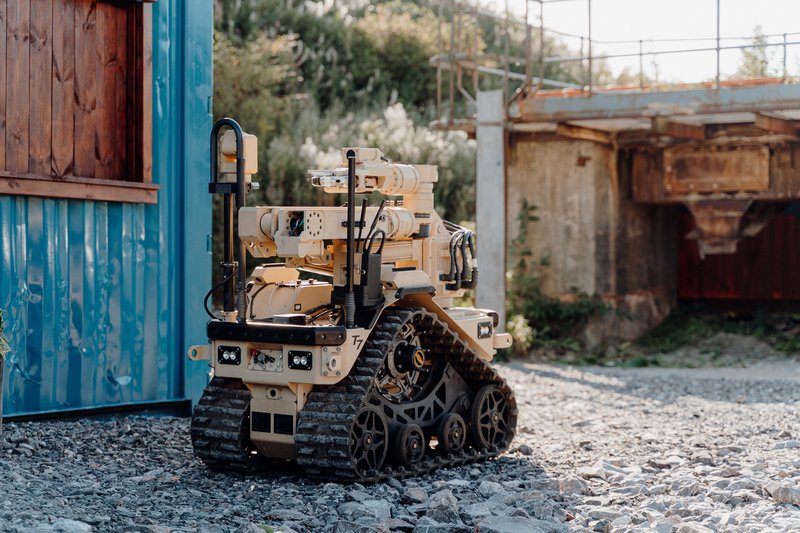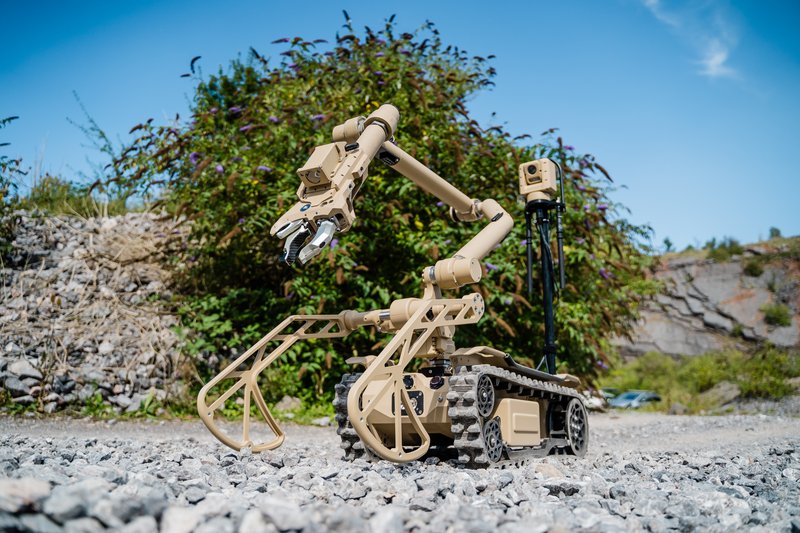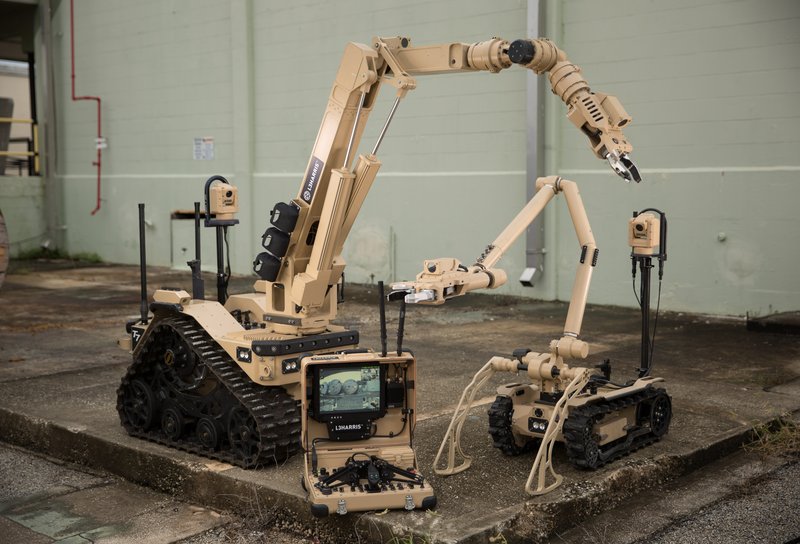L3Harris T7™ and T4™: Unrivaled EOD Capability Meets Proven Reliability
This article is brought to you by L3Harris
As a result, the tasks and missions being conducted by military specialists such as explosive ordnance disposal (EOD) teams are becoming more complicated. More than ever, these teams require the support of intuitive, reliable and available technology to help combat and address these threats.
Achieving the right balance
A key challenge EOD teams face when it comes to procuring robotic systems technology in particular is achieving the right balance between high-performing EOD capability and sufficient reliability. Because operators require a certain degree of capability to perform the demanding and time-sensitive tasks asked of them, this is often only achieved by compromising on the robot’s reliability. Teams will therefore opt to procure more capable yet complex robot technology that is more likely to fail or break down on a regular basis. In an evolving modern battlespace that demands mission agility, there shouldn’t be a need to make such a compromise.
Trusted by world-leading EOD military forces in the UK, US and Australia to support missions on a global scale, L3Harris’ large T7™ and medium-sized T4™ robotic systems offer the best of both worlds: highly intuitive, real-world EOD capability with proven, fielded reliability.

How can compromising on reliability impact mission success?
Making do with complex and unreliable robotic systems technology for the sake of increased capability can present EOD teams with several challenges:
1. Regular repairs and low availability
Overcomplicated, unreliable or poorly designed robots break frequently and often have to be shipped back to the manufacturer in the event of a failure. Due to lengthy repair cycles, this reduces how available the robot is for use and leads to costly downtime. It’s no good investing in a robot that will only make it through two or three missions before being returned to its supplier because a part needs replacing or damage needs repairing. Robots that break often also rapidly consume any supplied spare parts. This not only means paying out additional, unaccounted for costs to replace them but considerable delays while waiting for the new parts to become available. Any time lost to repairs, diagnostics and returning to the supplier results in reduced productivity and an impediment to mission success.
2. Unreliable robots are expensive
If robots in a fleet are inoperative due to maintenance or repairs on a regular basis, this downtime has an extensive impact on the success of a mission and an expensive impact on the through-life costs of the fleet. The cost to support unreliable robots can be significant year-on-year, from buying new parts to paying repair personnel for regular fixes. This can even include purchasing more robots than required just to ensure backup units are ready to compensate for any downtime. Moreover, long repair cycles mean even more cost is squandered – while waiting for the manufacturer to make the repair, all of the money invested in the dormant robot is wasted.
3. Highly capable robots can be complex to use
Oftentimes, harnessing more capable robot technology doesn’t always mean it’s easier to use. In fact, it can be very difficult for EOD teams to get to grips with, as many highly capable systems are more complicated to operate. Training an operator to use a new EOD robot is always less time-consuming and more cost-effective when the system itself is simple to use. An intuitive, reliable and available system means a much smaller training burden, leading to significant cost savings, happier operators and fewer mistakes made during missions. The easier a robot is to use, the smarter the investment.

L3Harris’ reliable robots offer revolutionary EOD capability
L3Harris’ T7 and T4 robots have been designed to offer military, security and law enforcement personnel unrivaled EOD capability, high availability and unmatched reliability without compromise. Purpose-built to address the key challenges EOD teams face, they empower operators to do their jobs to the best of their ability.
1. Built not to break
Every component used within the T7 and T4 goes through a rigorous design and selection process to ensure it is able to withstand use in extreme environments. Many of the major components in both systems were originally made for high-wear applications, so their parts last longer than typical robot components. Incredibly durable, the robots require next-to-no preventative maintenance, so very little time is ever lost on routine upkeep. If a repair is ever required, the vast majority can be completed easily, inexpensively and as far forward as possible by the customer in the field. This avoids the need to ship the system back to the supplier, saving valuable time and effort.
2. Through-life affordability
Designed to handle heavy, long-term usage without breaking, the T7 and T4 use up fewer spare parts, resulting in less downtime and reduced repair costs. Both systems also have multiple components in common, making it easier and cheaper to operate and support a whole fleet. An additional benefit of these common parts is that these can be stored in less space and more readily distributed to customer sites. The robots’ modular design further supports easy upgrades in the future, improving through-life cost.
3. Unmatched, intuitive robot control
The T7 and T4 share an intuitive haptic controller that makes operating the robots feel as natural as moving one’s hand, enabling operators to physically feel what the robot arm is doing. This offers unparalleled precision and human-like dexterity during complex tasks, maximizing mission effectiveness and minimising task completion time. Moreover, the controller is so easy to operate that it ensures training time and cost is significantly reduced. This results in incredibly high long-term skills retention, so even if a significant amount of time elapses between missions, picking the controls back up is simple.

Proven, real-world reliability trusted on a global scale
L3Harris’ T7 and T4 robots are being deployed all over the globe by three of the world’s leading military organizations to keep their people out of harm’s way. More than one hundred large T7 robots are currently in service with the UK Ministry of Defence, having replaced its legacy fleet for Project STARTER. Deployed in the U.K., Cyprus and Gibraltar, these robots respond to hundreds of EOD incidents per year.
Since June 2021, the US Air Force has also ordered more than 100 T7s to support global missions and help safeguard EOD operators. Recognized by the Air Force for its outstanding technical and usability ratings, the T7 represented a major upgrade from the previous 20-year-old robotic fleet, enabling operators to handle larger explosive devices in less time with increased speed, improved lift, reach, strength and extended battery life.
In May 2023, L3Harris was announced as the successful tenderer to provide up to 80 robotic systems to safeguard Australian Defence Force (ADF) personnel. Part of the Land-154 program, a mix of medium-sized T4 and large T7s will support in enhancing EOD unit capabilities in improvised explosive device neutralization and exploitation as well as route clearance. The ADF is the first organization to adopt both T7s and the T4s.
Discover more about how L3Harris robotic systems provide unrivaled EOD capability and proven, real-world reliability here or visit Stand H5-310 at DSEI 2023 from 12 – 15 September in London.
More from Industry Spotlights
-
![The power of partnership: GDMS–UK deepens cooperation with the British Army]()
The power of partnership: GDMS–UK deepens cooperation with the British Army
In Conversation: Shephard's Gerrard Cowan talks to General Dynamics Mission Systems–United Kingdom’s Chris Burrows about how the company's UK TacCIS business is reshaping battlefield communications through sustained customer engagement, accelerated innovation and ecosystem collaboration.
-
![Expanded focus – unleashing the potential of commercial SATCOM for defence]()
Expanded focus – unleashing the potential of commercial SATCOM for defence
In conversation... Intelsat's Ray Lindenmayer talks to Shephard's Gerrard Cowan about the new capabilities advanced commercial SATCOM technologies can provide for military customers, and how industry and government can best work together to achieve maximum effect in orbit.
-
![Enhancing education: How CAE is embracing new technology to boost military training]()
Enhancing education: How CAE is embracing new technology to boost military training
In Conversation... Shephard's Gerrard Cowan talks to CAE's Marc-Olivier Sabourin about how the training and simulation industry can help militaries achieve essential levels of readiness by leveraging new technology, innovative procurement methods and a truly collaborative approach.
-
![Why tactical UAVs are winning on the future battlefield (Podcast)]()
Why tactical UAVs are winning on the future battlefield (Podcast)
In Conversation: In this special edition of the Shephard Defence Podcast, Tony Skinner sits down with Dan Slasky, President and CEO of Aeronautics, to explore how cutting-edge tactical unmanned aerial systems are reshaping today’s battlefields.
-
![Fincantieri’s Vulcano Class: a new era of versatility and innovation in naval operations]()
Fincantieri’s Vulcano Class: a new era of versatility and innovation in naval operations
Logistic support ships (LSS) are essential for sustained naval operations, especially during extended deployments far from home ports.
-
![Need more flexibility in battle management system delivery?]()
Need more flexibility in battle management system delivery?
Systematic’s newest solution, SitaWare BattleCloud, brings greater flexibility to combat information systems and C4ISR.

























